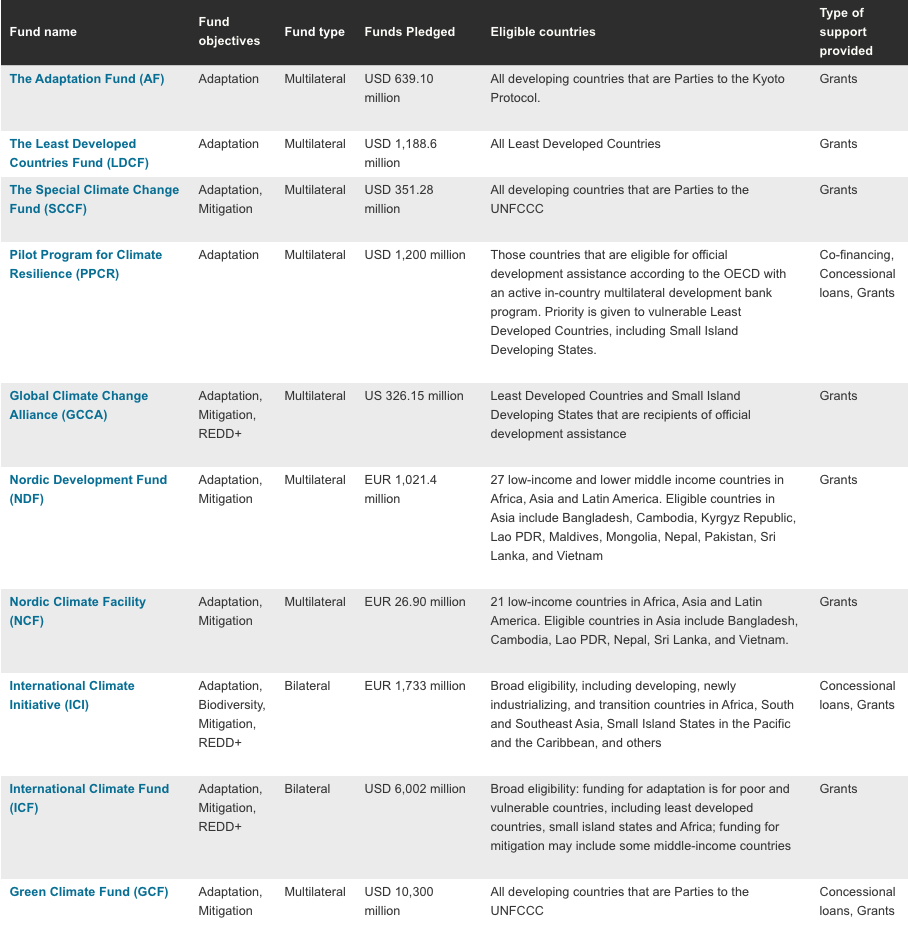Quick Guide to Climate Change Adaptation Funds

Introduction
The USAID Adapt Asia-Pacific Quick Guide to Climate Change Adaptation Funds is an easy to follow collection of 10 multilateral and bilateral climate funds and initiatives currently available for financing adaptation activities in developing countries.
Unlike other guides that provide lengthier descriptions, we have presented here only the need-to-know, essential bits of information. This Quick Guide provides key facts about individual funds, such as eligibility criteria, target areas, and, importantly, the mechanisms that will ultimately help you gain access and approval.
Developed by the USAID Adapt Asia-Pacific team of climate finance experts, the Quick Guide includes “Tips by USAID Adapt Asia-Pacific” with bite-size, handy information on how to get your projects funded. These tips are based on our on-ground experience working with country officials, implementing agencies and fund managers.
An outline of the guide is provided below. Download the full Quick Guide from the right-hand column. This is the second publication in the USAID Adapt Asia-Pacific Adaptation Finance Knowledge Series. For related resources see the Further Resources section below.
The Quick Guide
This Quick Guide features the following 10 funds that, combined, have provided the largest volume of adaptation financing to date. These include five multilateral funds and five bilateral funds, with two allowing for direct access:
- Adaptation Fund
- Global Climate Change Alliance
- Green Climate Fund
- International Climate Fund
- International Climate Initiative
- Least Developed Countries Fund
- Nordic Climate Facility [2021 update: no longer providing funding for adaptation]
- Nordic Development Fund
- Pilot Program for Climate Resilience
- Special Climate Change Fund
To date, money from these funds has been spent on a variety of sectors in Asia-Pacific, including disaster prevention, agriculture, coastal zones, water and sanitation, and infrastructure. International funds, however, provide only a piece of the adaptation financing puzzle.
The current funding available does not meet the projected needs for adaptation in developing countries. Countries also need to mobilize the additional domestic and, especially, private sector funds. But while more financial resources are still needed, existing funds are an important resource, and this Quick Guide helps potential applicants understand the different funds available.
Funded through USAID’s Regional Development Mission for Asia (USAID/RDMA) and implemented by AECOM, USAID Adapt Asia-Pacific was designed to share information and best practices about climate change adaptation finance modalities and project preparation tools and help governments build capacity to access the existing pool of international climate change adaptation funds.
Go to the USAID Climate Change Adaptation Project Preparation Facility for Asia and the Pacific (USAID Adapt Asia-Pacific) project page
Suggested Citation
USAID Adapt Asia-Pacific (2017) Quick Guide to Climate Change Adaptation Funds.USAID Regional Development Mission for Asia: Bangkok, Thailand.
The Adaptation Finance Knowledge Series
USAID Adapt Asia-Pacific has been helping countries develop bankable adaptation projects and improve their access to funding. These experiences, published in this series, are based on our work with governments, multilateral and regional organizations, and other experts.
- Guidelines for Designing Bankable Adaptation Projects (2016)
- 6 Things to Know about Urban Adaptation (2016)
- Analyzing the Economic Costs and Benefits of CCA Options (2016)
- Shortlisting Climate Change Adaptation Projects (2015)
- Quick Guide to Climate Change Adaptation Funds (2015)
- Defining Country Systems for CCA Finance (2015)
- The Exchange Series on Climate Financing (2013-2015)
- USAID Adapt Asia-Pacific Annual Meeting Proceedings (2012-2015)
(0) Comments
There is no content